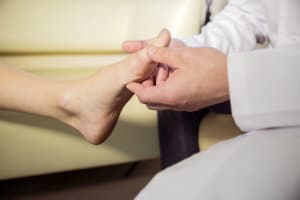Sick Feet: Infections and Gangrene
Any part of your body can suffer from an infection and end up with serious damage, and your feet are no exception. When an infection spreads, it can impact your foot function, and even contribute to tissue death. This effect is called gangrene, and it’s a life-threatening condition that could lead to a limb amputation.
How Feet Get Infected and Die

Gangrene is when a section of living tissue dies. It’s a severe complication of an infection, though injuries or conditions that severely restrict blood flow can cause it too. Without enough oxygen or nutrients, that part of the body will slowly die. A fracture, a blood clot, a dislocation—anything that damages blood flow, or can become infected, could potentially lead to dead tissue.
It’s most common in the extremities like your feet, too, since circulation is already weaker there, limiting the nutrients and oxygen reaching your tissues, as well as your immune system. Conditions that impair your circulation or immune system—like diabetes or peripheral arterial disease—have an even higher risk for gangrene complications.
Signs of Infection and Gangrene
Dead tissue on your body is extremely dangerous and can lead to septic shock, which is life-threatening. So, catching infections and gangrene early before they spread is extremely important. Basic infections start with mild symptoms, like inflammation, swelling, and pain in the affected tissues. You may notice redness around the infected area, and that part of your foot may feel hot to the touch. When an infection or injury deteriorates into gangrene, the symptoms get more serious.
Often the gangrenous skin will change colors, going pale and turning blue, black, purple, bronze, or even red depending on the type of gangrene. There’s usually a clear line where the dead skin ends and healthy skin begins. Deeper tissues that are affected will swell. The dying area of your foot will be painful at first but lose all feeling as more and more of it dies. It may feel cold to the touch. You may also start to run a fever and feel unwell.
Treating the Infection, Saving the Body
Infection isn’t something you should take lightly, even when it starts small. Ignored infections can get out of hand and lead to issues like gangrene—particularly in high-risk people with diabetes or circulation issues. If your foot develops gangrene, you need emergency care to save your limb. Our team at The Kansas Foot Center will examine your foot to diagnose infections before they become serious, or catch gangrene if it has already developed.
An infection will need medication to slow and kill the invading bacteria. Depending on how serious the infection is, you could take oral pills or need the medicine directly through an IV. Your foot and general health will have to be monitored to make sure the medication is treating the problem appropriately.
If you’ve developed gangrene, you’ll need emergency treatment to save your foot, or possibly your life. You’ll need medications to treat any infections, and the dead tissues will have to be removed. This prevents the dead areas from spreading to healthy parts of your foot. If the gangrene has spread too much over a toe or your foot, amputation might be your only option. Additional treatments like oxygen therapy may help your wounds heal more quickly.
Gangrene is a serious problem that shouldn’t be taken lightly. Whether it’s the result of an infection or something else, it can permanently take parts of your feet away from you. Worse, it can spread and put your life in danger. If you’re dealing with an infection, or you’ve noticed signs of gangrene, contact The Kansas Foot Center immediately for emergency care. You can reach our Wichita office at (316) 283-4330, or use our website to ask more questions. Don’t wait and risk losing your foot before finding help.
